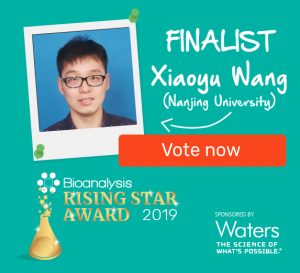Bioanalysis Rising Star Award finalist: Xiaoyu Wang
 The winner will be announced in the coming months! Follow Bioanalysis Zone on Twitter, Facebook or LinkedIn to be the first to find out the winner!
The winner will be announced in the coming months! Follow Bioanalysis Zone on Twitter, Facebook or LinkedIn to be the first to find out the winner!
Nominated by: Hui Wei, Nanjing University (China); [email protected]
Supporting comments:
“Xiaoyu is a PhD candidate in my research group in the Department of Biomedical Engineering at Nanjing University. I have been working closely with him for 4 ½ years. His work is focused on the development of high performance nanozymes for bioanalytical applications. In the past several years, his research work greatly promoted the development of nanozyme bioanalysis. Xiaoyu developed a straightforward and predictive activity descriptor for guiding the search for highly active peroxidase mimics, which provided the basic research for nanozyme bioanalysis. This interesting work was published by Nature Communications, which attracted great attention after publication and was highlighted by Phys.org. Besides this project, he also developed nanozyme sensors and sensor arrays for versatile analytes from bioactive small molecules to proteins and even cells. Some of these results have been published in Analytical Chemistry and Theranostics. He has won numerous prestigious awards, such as ‘The National Scholarship for Graduate Students’ and ‘2018 Baxter China Young Investigator Awards’ because of his academic achievements. Overall, Xiaoyu is a creative and collaborative researcher and I am confident in his potential for future success. Therefore, I most strongly and enthusiastically support his application for this prestigious Bioanalysis Rising Star Award.”
1Describe the main highlights of your bioanalytical work.
During my first bioanalytical study, I developed a ratiometric electrochemical biosensor for ascorbic acid detection. The obtained ratiometric response can substantially overcome intrinsic systematic errors of traditional electrochemical sensors and thus improve the reproducibility and robustness.
Subsequently, the main focus of my work has been evolved to developing bioanalytical assays with peroxidase-like nanozymes. Currently, the search for peroxidase-like nanozymes mainly relies on trial-and-error strategies. The rational strategies for designing effective nanozymes with peroxidase-like activity will promote nanozymes’ application for bioanalysis. I demonstrated that the efficacy of eg occupancy to predict and identify the peroxidase-like activity of perovskite oxide nanomaterials. According to the descriptor of eg occupancy, LaNiO3 was identified as the most active peroxidase mimic. Further, I constructed biosensors for some important biomolecules (e.g., H2O2, glucose and sarcosine) by using the peroxidase-mimicking LaNiO3 as natural enzyme’s alternatives.
Previous ‘one-to-one’ nanozyme biosensors are generally based on the pre-selected bio-ligands for specific recognition, which may not be available for the emerging analytes. To detect emerging analytes without pre-selected bio-ligands, I constructed nanozyme sensor arrays for detection and fingerprint identification of bioactive molecules, proteins and cells. Moreover, I developed nanozyme sensor arrays for tracking patterns to follow real-time biologically related events.






